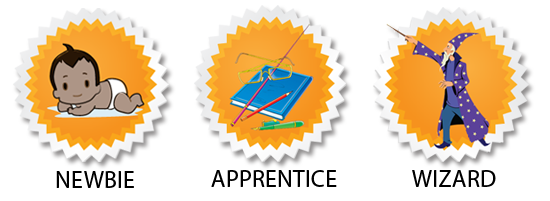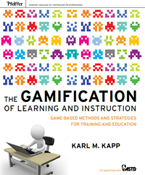
Ready for a challenge? How much do you know about gamification for learning? Find out by answering the questions below, which are based on Karl Kapp’s new book, The Gamification of Learning and Instruction.
INSTRUCTIONS: Answer each question below. Then read the “Karl Says” explanation to see if you’re right. Give yourself 10 POINTS for correct answers and zero for incorrect. Add up your score and check to see to see if you’re a Gamification Newbie, Apprentice or Wizard at the end. How did you do? Let us know in the Comments section below.

Members of a sales team are competing to get the highest score for a prize. Their desire to get the highest score is driven by:
a. Intrinsic motivation
b. Operant conditioning
c. Extrinsic motivation
KARL SAYS:
“Extrinsically motivated behavior … is behavior undertaken in order to obtain some reward or avoid punishment. It is when a person seeks to earn something that is not directly related to the activity.”
 What game element has been shown to influence a learner’s behavior in the real world when the game is over?
What game element has been shown to influence a learner’s behavior in the real world when the game is over?
a. Customizable character (avatar)
b. Reward for completing a task
c. Difficult goal to achieve
KARL SAYS:
“Creating avatars and having a learner perform a task as an avatar influences that person’s actual behavior outside of the virtual environment.”
 The blend of competition, cooperation, and self-expression elements in one game:
The blend of competition, cooperation, and self-expression elements in one game:
a. Confuses players
b. Encourages engagement
c. Rarely works
KARL SAYS:
“When considering what type of play to use for the creation of gamified content, keep in mind the blending of competition, cooperation, and self-expression. Allowing all three of these elements will encourage the most engagement and activity with the gamified content.”
 Of four common types of game players, which type is interested in acting ON the world.
Of four common types of game players, which type is interested in acting ON the world.
a. Socializers
b. Explorers
c. Achievers
KARL SAYS:
“Achievers are interested in acting on the world. Explorers are interested in interacting with the world of the game. Socializers are interested in interacting with players. Killers are interested in acting on other players.”
 What educational concept supports multilevel instructional games that increase in difficulty and require greater skill at each new level?
What educational concept supports multilevel instructional games that increase in difficulty and require greater skill at each new level?
a. Scaffolding
b. Self-determination theory
c. Competence theory
KARL SAYS:
“Scaffolding is process of controlling the task elements that initially are beyond the learner’s capacity, so that the learner can concentrate on and complete elements within his or her immediate capability. Once that task is accomplished, the learner is then led to accomplish another goal that builds upon the previous.”

The use of demonstration, observation and touch devices are effective game strategies for:
a. Improving problem-solving skills
b. Improving psychomotor skills
c. Changing values and attitudes
KARL SAYS:
“To teach in the psychomotor domain, design a game where the learners have the opportunity to observe a player within the game conducting the psychomotor activity or are able to use a haptic device to mimic the steps and receive tactical
feedback on the activity within the psychomotor domain.”
 When is the best time to present competitive achievements in a game?
When is the best time to present competitive achievements in a game?
a. When players first start the game
b. When players are familiar with the game
c. When players are at a master level
KARL SAYS:
“If competitive achievements are used in a game, make them available only after players are comfortable with game play and no longer learning the ropes.”
 True or false? The uncertainty of a reward releases more dopamine (a pleasure chemical) than a predictable reward.
True or false? The uncertainty of a reward releases more dopamine (a pleasure chemical) than a predictable reward.
a. True
b. False
KARL SAYS:
“The uncertainty of an outcome influences the brain’s response to reward. Uncertain rewards release more dopamine than predictable rewards.”
 True or false? The Facebook game FarmVille is an example of competitive play.
True or false? The Facebook game FarmVille is an example of competitive play.
a. True
b. False
KARL SAYS:
“Another good example of cooperative play is the social game FarmVille, which leverages aspects of the social network Facebook to encourage interaction and sharing among players.
 True or false? When starting a game design, it’s most effective to focus on the core interactions before delving into the content.
True or false? When starting a game design, it’s most effective to focus on the core interactions before delving into the content.
a. True
b. False
KARL SAYS:
“Prior to considering the treatment of the content within the game, consider the types of interactions that will drive the game play. Relate the interactions back to player and game types.”
ANSWERS
1-c 2-a 3-b 4-c 5-a 6-b 7-b 8-a 9-b 10-a
 If you’re intrigued by games and what they can do for your learners, then check out The Gamification of Learning and Instruction. I highly recommend it. You’ll never be able to make boring eLearning again.
If you’re intrigued by games and what they can do for your learners, then check out The Gamification of Learning and Instruction. I highly recommend it. You’ll never be able to make boring eLearning again.


Hi Mark,
Thanks for your kind words. As you can see, not everyone appreciated it 🙂 Since so many people were reviewing the book for Karl’s Blog Book Tour, I was looking for a different way to present the gems inside.
Best,
Connie
Connie, nice approach to a book review! I liked the ironic twist of the M/C style personally and figured … with you it must be by design 🙂
Cheers!
Hi Kathy,
I was waiting for someone to say this and it only took a few hours! I wanted to provide a book review in a unique way and to present some points from a book that I thoroughly enjoyed, that was really my purpose. It is not an example of a game that I would develop for my clients.
Maybe you can think of it as 10 quick lessons. It was an informal approach and was hoping my fellow eLearning peeps would understand and cut me some slack. Of course the labels are silly. But your comment is welcome and a good addition to this conversation and I’m glad you’ve been explicit about it so no one will misunderstand. Thanks for adding to the conversation and providing your opinions and insights.
Best,
Connie
To be a buzzkill here:
As you are well aware, the use of a multiple-choice quiz for which there is a single “correct” answer is typically a poor choice for measuring anything but pure facts. Also, the idea that we can put a label on someone like Newbie or Wizard *based on a nearly context-free multiple-choice quiz* is typically frowned upon in the learning communities I participate in. One of the things I find most disturbing about the conversation around gamified learning is that things we already know — and hold dear — are given a pass when it’s viewed as a “fun” gamification experience. The fact that this is all just part of a fun/game-like thing does not suddenly make it a useful tool.
My very first encounter (and subsequent push against) gamification was when the current gamification thought leader / Ted speaker suggested labeling people “experts” on a topic based on how many books they purchased about it from a single book vendor. While I understand marketers playing fast and loose with terms around expertise, I’m more squeamish when it turns up in learning circles.